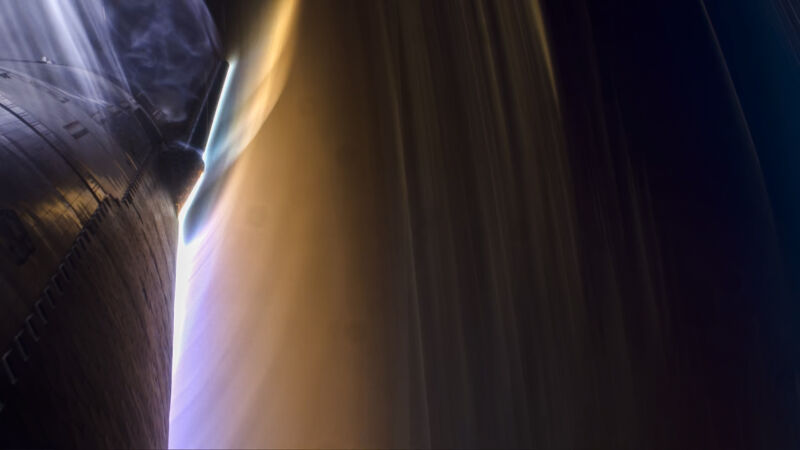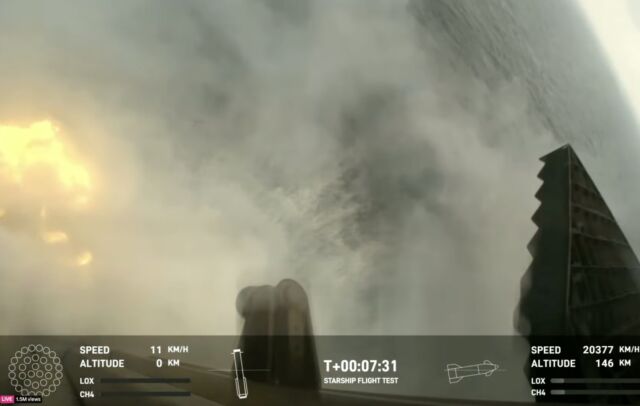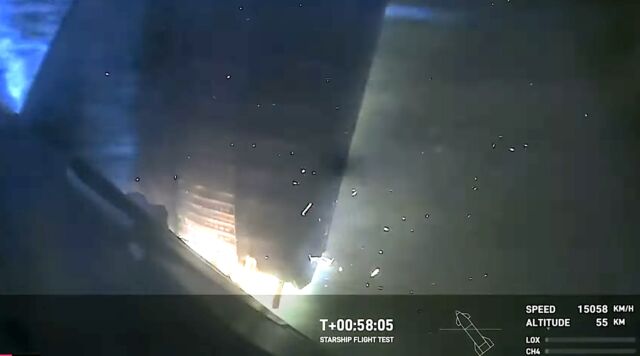“I think we should try to catch the booster with the mechazilla arms next flight!”

SpaceX demonstrated Thursday that its towering Super Heavy booster and Starship rocket might one day soon be recovered and reused in the manner Elon Musk has envisioned for the future of space exploration.
For the first time, both elements of the nearly 400-foot-tall (121-meter) rocket not only launched successfully from SpaceX’s Starbase facility near Brownsville, Texas, but also came back to Earth for controlled splashdowns at sea. This demonstration is a forerunner to future Starship test flights that will bring the booster, and eventually the upper stage, back to land for reuse again and again.
The two-stage rocket took off from Starbase at 7:50 am CDT (12:50 UTC) and headed east over the Gulf of Mexico with more than 15 million pounds of thrust, roughly twice the power of NASA’s Saturn V rocket from the Apollo lunar program of the 1960s and 1970s.
Checking all the boxes
Starship, the largest and powerful launch vehicle ever built, is key to the future of SpaceX. NASA also has an interest in Starship’s success because the agency selected it to fill the role of human-rated lunar lander for the Artemis program to ferry astronauts to and from the surface of the Moon.
There will be dozens more Starship flights before anyone actually climbs inside the Starship lander, and this probably won’t happen sooner than the latter part of this decade. But some of the other goals for Starship, such as recovering and reusing the entire rocket, appear within reach.
“The fourth flight of Starship made major strides to bring us closer to a rapidly reusable future,” SpaceX said in an update on its website. “Its accomplishments will provide data to drive improvements as we continue rapidly developing Starship into a fully reusable transportation system designed to carry crew and cargo to Earth orbit, the Moon, Mars, and beyond.”Advertisement
Thursday’s test flight was the fourth launch of a full-size Starship rocket and was the first to end with the booster and ship reaching Earth’s surface in one piece. The results matched the best of all possible scenarios leading up to Thursday’s flight.
It fell short of total perfection, but you can’t describe the flight as anything but a success. “The payload for this test was the data,” SpaceX said. “Starship delivered.”

Two of the 33 methane-fueled Raptor engines on the Super Heavy booster failed on Thursday’s test flight—one on the ascent and one during the booster’s final braking burn just before splashdown in the Gulf of Mexico. Still, the remaining engines guided the booster to a relatively gentle splashdown in the ocean after a vertical descent just off the coast of Starbase about seven-and-a-half minutes after liftoff. SpaceX got close to accomplishing this milestone on the third Starship flight in March but lost contact when most of its landing engines failed to reignite.
Engineers blamed filter blockage in the lines feeding liquid oxygen propellant into the Raptor engines for the landing failure in March. This didn’t appear to be a major problem on Thursday. SpaceX also made another change to the booster’s descent with the jettison during the descent of the rocket’s hot-staging ring, where the Starship upper stage attaches to Super Heavy for launch.
Meanwhile, six Raptor engines on the Starship upper stage burned a few seconds longer than planned to make up for the performance shortfall on the booster. This put the ship on the proper suborbital trajectory to reach a peak altitude of 132 miles (213 km) before Earth’s gravity pulled the 165-foot-long (50-meter) vehicle back into the atmosphere around 47 minutes after launch.Advertisement
The flight up to this point was just a prelude to the grand finale.
On SpaceX’s third Starship test flight in March, the scorching heat of reentry destroyed the rocket as it descended into the upper atmosphere over the Indian Ocean. SpaceX said clogged thrusters caused the ship to lose the ability to control its orientation in space. This caused the Starship to fall into the atmosphere in the wrong orientation, subjecting unprotected parts of the vehicle to the extreme heat of reentry.

This time, Starship maintained control throughout the flight. Dazzling live views from cameras aboard the rocket, relayed to the ground through SpaceX’s Starlink broadband network, showed purple and orange plasma pouring over the vehicle as it glided through the atmosphere over the Indian Ocean.
A few moments later, one camera showed pieces of the rocket, presumably ceramic thermal protection tiles, peeling away. There appeared to be damage to the hinge joint connecting one of the ship’s control flaps to the main body. Nevertheless, the damaged flap could still move and help control the ship using aerodynamic forces as it dived belly-first deeper into the atmosphere.
“Starship made a controlled reentry, successfully making it through the phases of peak heating and max aerodynamic pressure and demonstrating the ability to control the vehicle using its flaps while descending through the atmosphere at hypersonic speeds,” SpaceX said. These were the mission’s main objectives outlined by Musk before the launch.
Finally, three of the Raptor engines on Starship reignited, and the rocket flipped from a belly-down orientation to a vertical position a few hundred feet over the middle of the Indian Ocean, according to SpaceX. It was difficult to make sense of what the live camera views were showing because the splashdown happened at night halfway around the world from Texas.
But live telemetry data indicated the rocket slowed to a near stop as it reached the sea, then the communication feed cut off about 1 hour and 6 minutes into the mission.
“Despite loss of many tiles and a damaged flap, Starship made it all the way to a soft landing in the ocean!” Musk posted on X, his social media platform. “Congratulations SpaceX team on an epic achievement.”
ARS VIDEO
How Scientists Respond to Science Deniers
Steely performance
SpaceX workers erupted in raucous cheers at the company’s headquarters in Hawthorne, California.
“It was a little bit of use your imagination as you were going down with what we could actually see, but we were able to hear the ship did its landing burn,” said Dan Huot, a SpaceX spokesperson hosting the company’s live webcast of the flight. “Starship made it through reentry and did its first-ever landing burn. From South Texas to the other side of the Earth, Starship is in the water.”

SpaceX engineers were eager to observe the performance of Starship’s heat shield Thursday. The thermal barrier consists of some 18,000 hexagonal ceramic tiles, similar to the heat-absorbing tiles used on NASA’s space shuttle. During reentry, temperatures outside the rocket can reach 2,600° Fahrenheit (1,430° Celsius), hot enough to melt aluminum, a metal used in the structure of many launch vehicles.
Engineers selected a stainless steel alloy for Starship’s primary structure. This material is heavier than aluminum or carbon fiber, but is strong at cryogenic temperatures, an important characteristic because Starship consumes methane and liquid oxygen chilled to several hundred degrees below zero. Stainless steel also has a higher melting temperature than other materials commonly used on rockets.
“For a reusable ship, you’re coming in like a meteor,” Musk said in 2019. “You want something that does not melt at a low temperature. You want something that melts at a high temperature, and this is where steel is extremely good as well.”
The decision paid off Thursday when tiles stripped away and exposed parts of Starship’s stainless steel skin. Before this week’s test flight, Musk said Starship could fail during reentry with the loss of a single tile in some areas on the vehicle. It wasn’t clear where tiles fell away from Starship on Thursday, but Musk posted after the test flight that the favorable outcome “speaks to the incredible resilience of stainless steel at temperature.”Advertisement
He said SpaceX would further hone the stainless steel alloy used on Starship to withstand even higher temperatures, making the vehicle more robust for reentry from low-Earth orbit and perhaps the more blistering conditions for reentry from deep space.
What’s next for Starship? The fifth test flight could happen within a couple of months. The Federal Aviation Administration ordered mishap investigations following the first three Starship launches, which each ended before reaching their destinations. That likely won’t be necessary this time.
SpaceX has already test-fired the ship for the next test flight, and the booster could be hot-fired soon. The successful soft splashdown of the Super Heavy booster in the Gulf of Mexico on Thursday apparently made Musk confident enough to aim for an attempt to bring the booster back to Starbase for an onshore landing next time.
“I think we should try to catch the booster with the mechazilla arms next flight!” Musk posted on X, referring to SpaceX’s plan to snare a hovering booster with catch arms on the launch pad tower.

Other top priorities for the next phase of Starship testing include demonstrating SpaceX can restart a Raptor engine in space. This would show Starship could safely put itself into a stable low-Earth orbit with the ability to guide itself back toward reentry, rather than following a ballistic suborbital trajectory as it has for the initial test flights.
Once in orbit, Starship could be used to deploy Starlink Internet satellites and perform more refueling tests necessary for SpaceX to fulfill NASA’s lunar lander contract.
SpaceX may also make changes to the Starship heat shield to rectify the loss of tiles encountered on Flight 4. Engineers will also want to know why the two Raptor engines failed during the launch and landing of the booster.
Whatever SpaceX has in store for Flight 5, it’s a good bet space fans won’t have to wait long.




